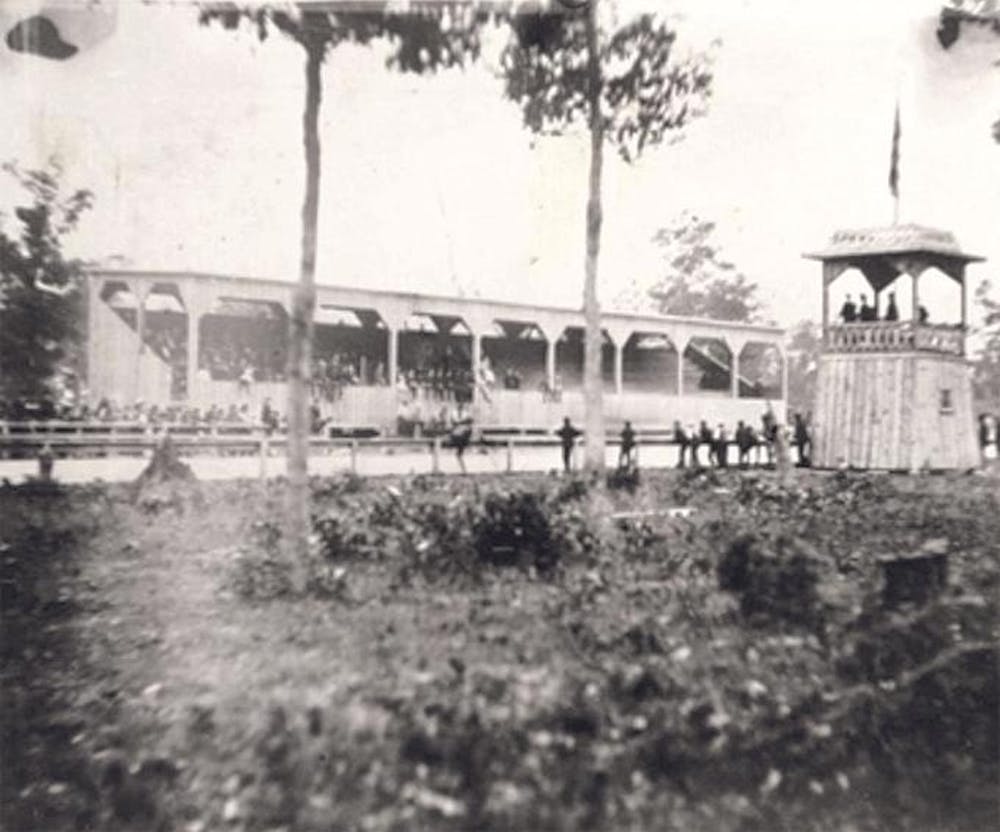During the 1860s the towns of Whitehall and Montague were established at the outlet of the White River along the west shore of Michigan’s Lower Peninsula. The water from this outlet filled the area known as White Lake before continuing to flow into Lake Michigan. This area was populated by numerous sawmills that processed the virgin white pine logs that were floated down the river.
The lumber industry was critical to starting a robust economic environment that helped the fledging towns grow and attract people. During the 1870s the lumber industry experienced its most aggressive growth, which led to a more secure lifestyle for the residents. Many people had a desire for more agricultural pursuits as residents and farmers converted soil that once grew trees into soil that could grow corn, wheat, oats, etc.
One of the most enjoyable pursuits for many people was the annual county fair. It was an opportunity for local farmers to show off their produce, stock, etc., and if judged to be in the top three, one could win money, or products provided as premiums by local businessmen. The only county fair in operation by the mid-1870s was the Oceana County Fair in Hart. Participation in the Oceana County fair by White Lake area residents required a nearly 40-mile round trip, which was not feasible for many.
Efforts were undertaken to develop a fair for the White Lake area by organizing the White Lake Agricultural and Industrial Society (WLAIS) in 1875 with some of the initial membership composed of Charles C. Thompson, Albert Mears, William T. Croxson, Eli M. Ruggles, Frank Blackmarr, Warren Wilder, Rober Wood, Kenneth F. Morse, James J. Gee, A. C. Elsworth, John C. Lewis, Albert Linderman, and Paul Hedges.
Several meetings took place to elect board members and develop committees and in 1878 plans began in earnest to hold a fair in the White Lake area. Securing a site for a fair was a challenging task since a vast majority of the membership and businessmen resided in Whitehall and were determined that the fair would be held in that fledgling town.
Charles Cook was a Montague businessman who had a sizable farm on the north side of White Lake. He served on the executive committee for the WLAIS and was interested in advancing the agricultural interests of the area. In August 1878 he offered WLAIS five years’ free use of 40 acres of his land for the purpose of a fair. The land had been cleared and fenced, had a good well of water established, had a sidewalk partially completed to the land (which he offered to finish), would have buildings and sheds constructed at his expense, and would also construct a half-mile track at his expense. This nearly unbelievable offer was very generous, and one would think that the WLAIS would have accepted it quite readily.
The WLAIS board meeting of Sept. 2, 1878, included a report from the committee on securing funds and erecting buildings. The report stated several good offers for grounds were received but thought that for the coming fall the offer made by Albert Mears was the most feasible. Mr. Mears offered the use of his lots on the corner of Colby Street and Mears Avenue, and it was thought that erecting the necessary sheds around the lots would nearly enclose the area. The board unanimously accepted the offer and instructed the committee to commence with the necessary improvements. It is unknown if Albert Mears’ position as the WLAIS board president had an influence on the decision.
A site being secured, the first fair in the White Lake area took place Oct. 1-4, 1878 in Whitehall, and was deemed a “grand success” that exceeded expectations, with nearly 600 entries. Total earnings from the fair amounted to $451.15, with expenditures amounting to $240.14, leaving net earnings at $211.01, which was impressive for a first fair.
The success of the first fair showed all participants and organizers the effort required to make such an endeavor functional. Some members of the WLAIS embraced the challenge while others decided that their time was better spent on other activities. During 1879 the board president, Albert Mears, was not present for several WLAIS board meetings, even for the Aug. 19 meeting, which he specifically called. Absence of committee members and executive positions highlighted the difficulty found in maintaining commitment from members.
Difficulties were overcome and the second annual fair of the WLAIS was held Oct. 7-10, 1879. The total earnings from the fair amounted to $268.60, with expenditures/premiums amounting to $243.97, leaving net earnings at $24.63. The carryover amount of $211.01 from 1878 added to the 1879 earnings left an operating balance of $235.64 for the Society in 1880.
It is possible that some members could foresee that the fair would not be able to continue with such meager profits, and there were probably some rumblings of discontent from participants from Montague that the activities were continuing to be held in Whitehall. Efforts were still underway by the WLAIS to acquire suitable property to serve as the fairgrounds, but success had not been achieved.
The WLAIS engaged in the required actions during 1880 to host the third (and final) annual fair Oct. 11-14. It was during this year that a group of individuals created the White Lake and West Oceana Agricultural Society (WLWOAS), possibly as a result of their dissatisfaction with WLAIS. Horse racing was an important and profitable part of a fair and the WLAIS had been unable to acquire property that would allow that activity. Charles Cook had previously offered appropriate property that would allow horse racing, but it is probable that the businessmen of Whitehall did not want the fairgrounds to be near Montague.
The WLWOAS had a board of directors composed of the following individuals all residing in Montague: Samuel H. Lasley (President), William J. Mason (Treasurer), George E. Dowling (Secretary), Charles H. Cook, and Hosea D. Johnson. The WLWOAS utilized the 40-acre property developed by Charles Cook to host their first annual fair in 1881.
Charles Cook had invested considerable resources to develop the fairgrounds in an effort to lure the fair from Whitehall to Montague and had been successful. Mysteriously, in 1882 he stopped paying taxes on the fairground property and Muskegon County foreclosed. George Dowling acquired the property in a tax sale Oct. 6, 1885. During this three-year span resources were expended, improvements made, and fairs held even though ownership of the property was not clear. George Dowling provided a quit claim deed to the WLWOAS March 31, 1886, for one dollar to clarify ownership of the fairground property.
The annual fairs held by the WLWOAS were profitable and allowed for continued investment into the property. A racing track was constructed, and A. R. Rogers was hired to acquire clay and incorporate it into the track. Mr. Rogers owned a farm which had an ample supply of clay, and in January 1884 used dynamite to loosen it from its bed. The clay was then transported to the racetrack and incorporated into the surface. Railings and a 1,000-seat grandstand with an asbestos roof were completed in 1885 to further provide a quality racetrack.
The fairgrounds served a dual purpose as a racetrack for the Montague Driving Association. This association was made up of some of the same individuals involved with the WLWOAS and focused on attracting people who had an interest in horse racing. The first races held by the Montague Driving Association occurred July 2-4, 1885, and were considered successful, but once completed the focus of the board members shifted to preparation for the upcoming fair.
The board members of both the WLWOAS and the Montague Driving Association were encouraged by the success of the July races and the fair attendance in 1885 but were noticing ominous signs in 1886 when the July races experienced less than expected attendance even with fine weather during the events. The fair, which took place Sept. 27-30, 1886, experienced poor participation and attendance, and the receipts fell far short of covering the expenses.
The Hart vs. Montague baseball game was part of the fair entertainment but failed to come to fruition as the Hart team leveled accusations that Montague imported men to play on their team.
The game started after the accusation was addressed but lasted only to the third inning when the Hart pitcher engaged in a squabble with the umpire, which led to a breakup of the game and disgusted spectators. The Hart team was outperforming Montague and most likely would have won the game and the premium if they had continued.
The challenges faced by the fair and the horse races were indicative of the economic and social environment of the White Lake area. The halcyon days of the lumber era were a distant memory for nearly everyone as the lumber resources had been exhausted. Lumber mills were shut down permanently and many people faced tough decisions brought on by the need to survive. This condition was not conducive to volunteer activity and led to greater responsibility and workload to those individuals who were helping to bring the fair and horse races to fruition.
A common problem for associations or societies is sustained participation by volunteers. When an insufficient number of volunteers is experienced, the association or society inevitably dissolves. This was the case for the WLWOAS as it sought assistance from the population but was unsuccessful. The final fair held by the WLWOAS Sept. 24-27, 1889 experienced frigid weather which led to receipts being less than expenditures. The Oct. 16, 1890, issue of the Montague Observer summed up the fate of the WLWOAS:
“Hart had a good fair. Fremont had a good fair. Big Rapids had a good fair. Montague might have had a good fair had the people been alive to their best interests.”














